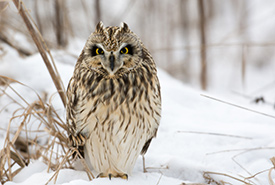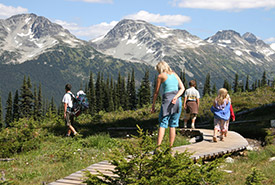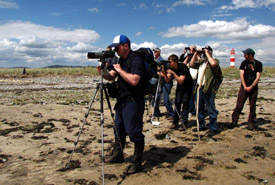Go wild for wildlife

Short-eared owl (Photo by Tony Campbell)
March 3 is World Wildlife Day, an annual event started by the United Nations General Assembly in 2013 to help raise awareness and encourage the celebration of our planet’s wildlife. In honour of this occasion, here are some ideas for connecting with wildlife:
Volunteer at a conservation organization or wildlife rehab centre
Volunteering is an excellent way to give back and to experience wildlife, as well as to meet others with similar passions and interests. The Nature Conservancy of Canada (NCC) hosts Conservation Volunteers events, such as bioblitzes (species counts), invasive species removals, native species plantings and shoreline cleanups, that allow you to make a difference for native habitats and species while acquiring hands-on conservation experience. You can also lend a helping hand to one of many wildlife rehabilitation centres across the country, such as the Toronto Wildlife Centre or Hope for Wildlife in Nova Scotia.
Take a hike or visit your local park

Family hiking near the mountains (Photo courtesy ParticipACTION)
Hiking is probably the best way to connect with wildlife in its natural habitat ― and you don’t necessarily have to venture far to do it. You can even see wildlife, such as songbirds, waterfowl, squirrels and rabbits, while taking a stroll at your local park. With the right clothing and gear, you can hike year-round. If you’re not sure where to go, check out NCC’s Nature Destinations across Canada.
Birdwatch

Birdwatching at Sandy Point, NL (Photo by Aiden Mahoney)
You don’t need much equipment to go birding — just a pair of binoculars and a recording device are enough. Many smartphones have built-in audio recorders. Although not mandatory for birdwatching, field guides, such as Sibley’s or Peterson’s, mobile apps, such as Merlin Bird ID — complete with bird songs that you can use to train yourself to identify birds by ear, and a camera — are helpful extras to bring along. Some NCC properties that are ideal for birding include the Tatlayoko Lake Bird Observatory in British Columbia and Johnson’s Mills Shorebird Reserve in New Brunswick, especially during the summer migration season.
Write about wildlife sightings
Seeing wildlife is exciting and memorable. Next time, write about your experience. You can even share your story on social media. Many of NCC’s Land Lines blog posts are about seeing wildlife, so consider sending your story our way.
Related blog posts
Snap wildlife photos
The next time you head out on a nature outing, don’t forget your phone or camera to capture photos of animals and plants that catch your eye. Then, share them with your followers and conservation organizations on social media. If you're camera savvy, consider providing fresh images of flora and fauna for an organization’s use.
Draw what you see
If you love to draw or paint, consider capturing animals or plants on paper. The next time you head out on a nature excursion, bring your art supplies, set up where you can observe your muse without disturbing it, and paint the day away. If you can’t make it outside or live far from nature, find a photo of a plant or animal and draw or paint it.
Watch wildlife documentaries
Appreciate and learn about wildlife from your couch by screening nature documentaries or television shows. Streaming sites like Netflix offer plenty to choose from, including Planet Earth, Planet Earth II, Blue Planet and Blue Planet II. If you don’t have a Netflix account, there are nature television channels you can subscribe to, such as Love Nature (formerly called Oasis TV), Nat Geo Wild or Animal Planet.
Visit a zoo or aquarium
If you want to get up close and personal with wildlife, but live far away from the wilderness, pay a visit to a zoo or aquarium. Not only does this allow you to observe animals that you may never have a chance to see in the wild, it can also help you form a personal connection with them. If you have children, bringing them to zoos can help them develop a healthy respect for wildlife.
Snorkel or scuba dive
With March Break fast approaching, you may be going south to get your fill of sun, sand and sea. Many countries south of the border are ideal spots for snorkelling and/or scuba diving. Once the weather warms up, there are also places in Canada with great scuba diving, such as Tobermory, Ontario. Snorkelling and scuba diving allow you to experience another world — under the water — and marvel at its beauty.
Hotels often provide snorkelling and scuba gear, organize expeditions and offer lessons. For scuba diving, it is highly recommended that you acquire at least your open water diver certification through PADI before doing this activity. If you can’t make it south, some aquariums, such as Ripley’s Aquarium of Canada in Toronto, allow you to scuba dive or snorkel in their tanks.


